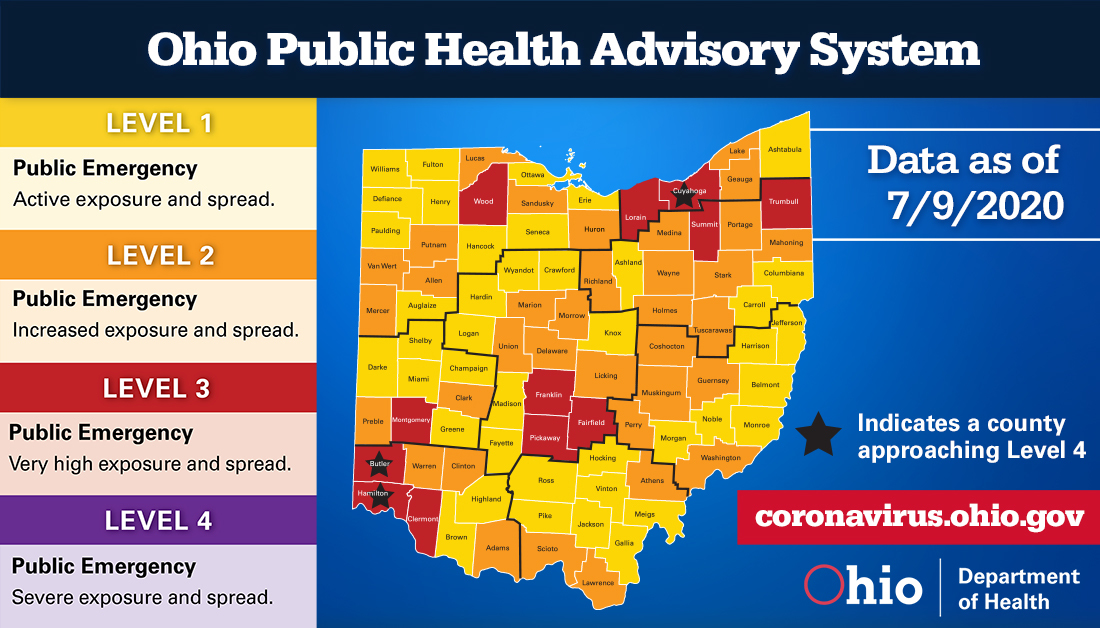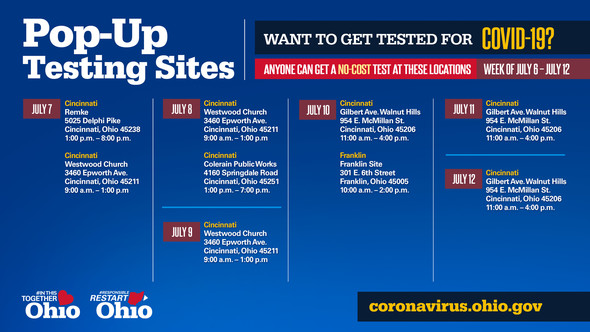FOR IMMEDIATE RELEASE:
July 9, 2020 |
MEDIA CONTACTS:
Dan Tierney: 614-644-0957
Breann Almos: 614-799-6480 |
COVID-19 Update: New Risk Levels, Higher Education Guidance, Funding for Schools, Homelessness Grant, IMAP Launch, SharedWork Program, Plasma Donation
(COLUMBUS, Ohio)?Ohio Governor Mike DeWine and Lt. Governor Jon Husted today provided the following updates on Ohio's response to the COVID-19 pandemic.?
UPDATED COUNTY RISK LEVELS
Governor DeWine announced today that new public health data has led the Ohio Department of Health to designate 12 counties as being in a Red Alert Level 3 Public Emergency as defined by the Ohio Public Health Advisory System.
|
Upgraded to Level 3:
- Clermont
- Fairfield
- Lorain
- Pickaway
- Summit
- Wood
|
Continuing at Level 3:?
- Butler*
- Cuyahoga*
- Franklin
- Hamilton*
- Montgomery
- Trumbull
|
Downgraded to Level 2:
|
Three Red Alert Level 3 counties marked with a star (*) are on Ohio's Watch List as they are approaching Purple Alert Level 4. Franklin County was removed from the Watch List due to a decrease in hospital admissions.
Mask mandates for the new counties upgraded to Red Alert Level 3 will be mandated to begin wearing masks in public beginning at 6 p.m. on July 10, 2020. Residents in Huron County are no longer required to wear a mask in public, however, they are strongly encouraged to do so.
 Governor DeWine announced the creation of the?Ohio Public Health Advisory System last week to?provide local health departments, community leaders, and the public with data and information on the severity of the COVID-19 spread in the counties in which they live.?The system consists of four levels with specific risk-level guidelines. Each level is calculated with data gathered on?seven public health indicators.?
HIGHER EDUCATION GUIDANCE:
The Ohio Department of Higher Education, in consultation with Ohio colleges, universities, the Ohio Department of Health, and health experts across the state have developed guidance to help campuses safely reopen.
The Responsible RestartOhio guidance for Institutions of Higher Education includes minimum operating standards for all campuses, as well as best practices to further enhance those standards.
"By implementing these minimum requirements and implementing best practices, our higher education communities can continue to educate students and prevent the spread of COVID-19," said Governor DeWine.?
Because each campus must develop policies and procedures related to COVID-19 testing, new Guidance for COVID-19 Testing at Institutions of Higher Education was also released to help institutions tailor their testing plan to their community and develop policies related to the isolation of symptomatic students, faculty, and staff members.
K-12 AND HIGHER EDUCATION FUNDING:?
To help K-12 schools and institutions of higher education address increasing costs associated with the COVID-19 safety measures, Governor DeWine and leaders of the Ohio General Assembly are requesting that the Ohio Controlling Board approve an initial request on Monday to allocate $200 million for higher education and $100 million for K-12 schools from the Coronavirus Relief Fund.?
"This funding comes from federal CARES Act dollars to help schools meet their unique individual needs," said Governor DeWine. "We intend for this funding to be very flexible to prevent the spread of COVID-19."
The funding would be available to all public and private schools and for all two and four-year colleges and universities, both public and private, including adult career tech providers.
The funding request is in addition to the more than $440 million in direct federal CARES Act funding that Ohio K-12 schools are receiving and the more than $190 million in direct federal funding provided to Ohio's colleges and universities.
HOMELESSNESS GRANT:?
Governor DeWine announced that he is awarding an additional grant of $15 million to?the Coalition on Homelessness and Housing in Ohio.?
The funds will be used to?support homelessness prevention efforts and rapidly rehouse individuals and families experiencing homelessness who could be at greater risk of contracting COVID-19, especially those in congregate facilities such as homeless shelters. ?
The grant funding is in addition to a $1 million grant that Governor DeWine award the coalition in April which helped to keep hundreds of Ohioans safely housed during the pandemic.?
IMAP LAUNCH:
Lt. Governor Husted announced the launch of the Individual Micro-credential Assistance Program (IMAP) which will provide $2.5 million in grants?to help unemployed Ohioans earn in-demand, technology-focused credentials that will give them a leg up in finding a job in the increasingly tech-focused economy.
The grant application is open to training providers, such as universities, colleges, Ohio technical centers, or private sector training businesses.?Training providers who receive awards will be reimbursed up to $3,000 for each completed technology-focused credential issued and up to $250,000 per provider.
The program was created in partnership with the Ohio House of Representatives.?
Training providers interested in applying can find more information at IMAP.Development.Ohio.gov.?The deadline to apply is July 24, 2020.
SHAREDWORK PROGRAM:?
Governor DeWine recently signed an executive order enabling the Ohio Department of Job and Family Services (ODJFS) to use federal funding authorized under the CARES Act to enhance the state?s SharedWork program.
Participating employers agree to reduce the affected employees? hours by a uniform percentage, between 10 percent and 50 percent, for up to 52 weeks.?In return, those employees receive SharedWork compensation (which is a prorated unemployment benefit) and, while federally available, may also receive the Pandemic Unemployment Compensation benefit each week.
Since March 15, ODJFS has approved 909 employers who have participated in 1,680 SharedWork Ohio plans, benefiting 46,352 participating employees.
For more information visit?jfs.ohio.gov/ouio/SharedWorkOhio.
PLASMA DONATION
Lt. Governor Husted encouraged Ohioans who have been fully recovered from COVID-19 for at least two weeks to consider donating plasma.?
"Convalescent plasma, which is plasma from recovered COVID-19 patients, is rich in antibodies that could possibly attack the virus that causes COVID-19," said Lt. Governor Husted. "Although the treatment of COVID-19 patients with convalescent plasma remains?in the investigation stage, it shows promise to lessen the severity or shorten the length of COVID-19 and is?something that could potentially save lives in our continual fight against the coronavirus."
For more information or to sign up to donate, visit?redcrossblood.org/plasma4covid or contact a local blood donor or plasma collection center.
CURRENT COVID-19 DATA:?
There are 61,331 confirmed and probable cases of COVID-19 in Ohio and 3,006 confirmed and probable COVID-19 deaths. A total of 8,570 people have been hospitalized, including 2,146 admissions to intensive care units.?In-depth data can be accessed by visiting coronavirus.ohio.gov.?
Ohio is offering free COVID-19 testing for all residents at pop-up testing sites across Ohio. Pop-up testing locations for July 7 - July 12 are listed below.?
Video of today's full update, including versions with foreign language translation, can be viewed on the?Ohio Channel's YouTube page.?
For more information on Ohio's response to COVID-19, visit?coronavirus.ohio.gov?or call 1-833-4-ASK-ODH.

|
